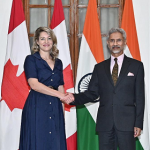Canadian foreign minister Melanie Joly is set to notch up a rare record – becoming a foreign leader to visit India twice within 30 days. She held a strategic dialogue with external affairs minister S Jaishankar in Delhi on February 6 and will return here for the G20 foreign ministers meeting in early March. The mutual endeavour is to utilise these opportunities optimally to address the factors that strained relations in the past and to elevate the bilateral relationship at a time when the geopolitical churn demands a stronger equation between Delhi and Ottawa.
Recognising the significance of public diplomacy and the growing clout of India’s strategic community, Joly began her visit with a curated engagement with scholars, business figures, thought leaders, and former diplomats, hosted by the Ananta Centre on February 6. This preceded her official meeting with her counterpart. Her main focus was on Canada’s Indo-Pacific strategy, launched by her in Vancouver last November. Since the event was largely ignored in India earlier, she seemed keen to explain its rationale, implications, and likely impact to a select audience, including this author.
Given its commitment to play a bigger role in the Indo-Pacific, India would do well not only to comprehend where Canada is coming from but also agree to work with it by showing greater enthusiasm. New Delhi has welcomed the Canadian strategy without saying more. It is, therefore, desirable to dissect Canada’s policy announcement and assess its likely relevance to India.
Canada’s Indo-Pacific strategy took over three years to finalise. This made it the last G7 country to do so. The need to formulate a new policy arose from two factors: Serious tensions in Canada-China relations caused by the former’s arrest of a senior official of Huawei, the Chinese telecommunication company, in December 2018, accompanied by China’s aggressive behaviour in the region; and Canadian assessment that upheaval in the Indo-Pacific after Covid-19 and the Ukraine conflict required the nation to align its policy closely with the United States (US) and other western partners. The strategy portrays Canada as a Pacific country with an Indo-Pacific neighbourhood. By Ottawa’s definition, the region comprises 40 countries stretching from Japan to Pakistan, which hosts 50% of the world population and will contribute 50% of the global Gross Domestic Product by 2040. The main constituents in the region are China, India, the North Pacific, and the Association of Southeast Asian Nations (ASEAN).
The policy document is remarkably candid about China, depicting it as “an increasingly disruptive global power.” Executing a strategic pivot away from an ultra-friendly approach to Beijing in the past, Canada now has “a clear-eyed understanding of this global China”, stressing that the Asian hegemon was making large-scale investments to establish its economic influence, diplomatic impact, offensive military capabilities and advanced technologies. Canada’s policy now is to challenge China to defend Canadian interests and cooperate with Beijing to address “some of the world’s existential pressures”. The key will be to work more closely with its partners, mostly from the North Pacific (the US, Japan, and South Korea) and elsewhere (Australia, ASEAN, and India).
Canada is seeking five fundamental objectives through the new strategy: Promoting peace, residence, and security; expanding trade, investment and supply chain resilience; investing in and connecting people; building a sustainable and green future; and Canada serving as an active and engaged partner to the Indo-Pacific. Unlike many other governments, Canada adopts a pragmatic approach. It believes that a new strategy needs new investment. Therefore, it plans to spend 2.3 billion Canadian dollars over the next five years. The break-up of this allocation reveals Canadian priorities. Over 30% of the outlay is meant to reinforce Canada’s Indo-Pacific naval presence, increase participation in military exercises, and develop cybersecurity capabilities. But about 40% has been set aside for creating sustainable infrastructure, economic development, and a healthy marine environment.
Joly emphasised that India is central to its Indo-Pacific strategy. This may sound good, but the difficulty is that Canada’s approach toward India is still guided largely by commercial considerations. It is focused on securing an Early Progress Trade Agreement and, eventually, a Comprehensive Economic Partnership Agreement. Where are the defence cooperation and maritime security-related measures? Presumably, the two foreign ministers discussed, behind closed doors, the more sensitive issues that divide the two governments: Counterterrorism, counter-radicalisation, and curbing the anti-India activities in Canada. Bilateral relations in recent years have been marked by some bitterness. The two sides need to craft a solid mutual understanding and appropriately take their people into confidence.
India may be somewhat pleased with Canada’s Indo-Pacific strategy, but Delhi seems to expect Ottawa to do more to enhance the strategic quotient in this relationship. Many pathways have been suggested, including by the Canada-India Track 1.5 Dialogue which ran from 2018-2020. It is time to absorb, reflect and act.
Rajiv Bhatia is Distinguished Fellow for Foreign Policy Studies, Gateway House, and a former ambassador.
A version of the article earlier appeared in Hindustan Times.


